
| WWT Shows | CLICK TO: Join and Support Internet Horology Club 185™ | IHC185™ Forums |

|
• Check Out Our... • • TWO Book Offer! • |
Welcome Aboard IHC185™  Internet Horology Club 185
Internet Horology Club 185  IHC185™ Discussion Site Main Page
IHC185™ Discussion Site Main Page  Interesting Horologically Based Stories
Interesting Horologically Based Stories  Larry Buchan's ..."Tales from the Rails"
Larry Buchan's ..."Tales from the Rails"  Railway Potholes
Railway Potholes
 Internet Horology Club 185
Internet Horology Club 185  IHC185™ Discussion Site Main Page
IHC185™ Discussion Site Main Page  Interesting Horologically Based Stories
Interesting Horologically Based Stories  Larry Buchan's ..."Tales from the Rails"
Larry Buchan's ..."Tales from the Rails"  Railway Potholes
Railway PotholesGo  | New Topic  | Find-Or-Search  | Notify  | Tools  | Reply to Post  |  |
| Railway Historian IHC Life Member Site Moderator |
This is what happens when you leave a locomotive in throttle 8 for a few hours when the train brakes are in full application, or in a stall situation. 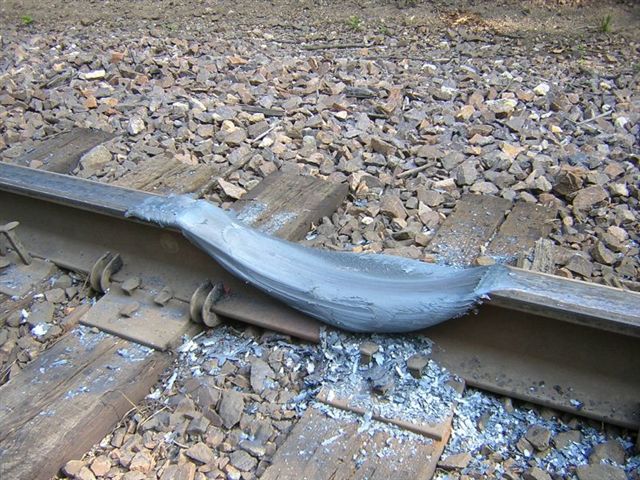 | ||
|
| Railway Historian IHC Life Member Site Moderator |
You can see two sets of axles that did this track damage in the foreground, and the three sets from the other end of the locomotive in the distance. Larry 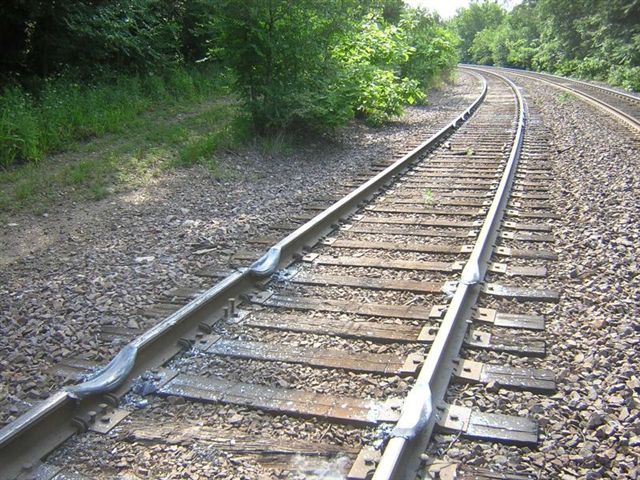 | |||
|
| IHC Vice President Pitfalls Moderator IHC Life Member |
Amazing! I would have thought there would be some kind of sensors & controls on the locomotive to prevent that from happening. Looks like it got pretty hot, to deform the rail that way. I expect someone got in trouble over that. Best Regards, Ed | |||
|
When I was a SP hostler in L.A I seem to remember that the wheelslip indicators on any one traction motor would have dropped the load. | ||||
|
| Railway Historian IHC Life Member Site Moderator |
Hello Jon: CPR pioneered locotrol (mid-train remote locomotives controlled by radio signals) in the mid-1960s, these remote locomotives or "slave" units as they were called could be controlled independently from the lead or "master" locomotive. And despite of the wheel slip indicators, what happened here is quite possible if set up in independent motoring, with this technology, we used to run grain, potash, and bulk sulfur trains of about 112 cars with the "slaves" located two thirds back from the "master" units when working through the undulating conditions in the Rocky mountains west of Calgary you could have the "slaves" in throttle 2 with the "master" in throttle 8, one problem we did have was a loss of continuity in the downgrade spiral tunnels, this would happen when the "slaves" and "master" lost communication with one another, so when we had the grade balanced the "slaves" would be usually placed in dynamic brake 6 in independent motoring, as when in multiple unit position the "slaves" would automatically go to idle position when they entered the tunnel and continuity was lost. Larry Ed I don't know all the particulars of what happened in this situation, but I'm sure somebody would be on the carpet answering questions if it was an employee error. | |||
|
You can also imagine what the trucks looked like also. BLUE It seems to me I have seen photos like this quite a few years ago and the engine and wheel truck were together on the side track getting new wheels. Bill Bill Carlson | ||||
|
| Railway Historian IHC Life Member Site Moderator |
Hello Bill: I can imagine that the air was pretty blue too, lucky they didn't start a fire, from what I have learned this incident happened on the Norfolk Southern, did the Burlington Northern use any of this technology in your territory? I remember seeing a BN remote control car on loan up here on the CPR back in the 1970s. Locotrol was originally developed by the Northern Electric Company in the 1960's and purchased by Harris Controls, from what our CPR instructors told us it was to be used by NASA but proved out to be too bulky system. Harris Controls was taken over by GE Transportation Systems, and the first customers to use the technology were the Southern Railway, Norfolk and Western Railroad, Canadian Pacific Railway, and the Queensland Rail of Australia. The original electronics were mounted in a separate railcar ran in front of the slave units, later on the size of the equipment was reduced small enough to fit into the front nose of the slave unit, that saved the railways money by being able to add an extra car to the train, and reduce the pay scale to the locomotive engineer who was being paid about an extra $2.54 a trip for handling this extra equipment whether working or deadheading. I've attached a photo showing one of the original test trains on the CPR with the special electronics car. Larry 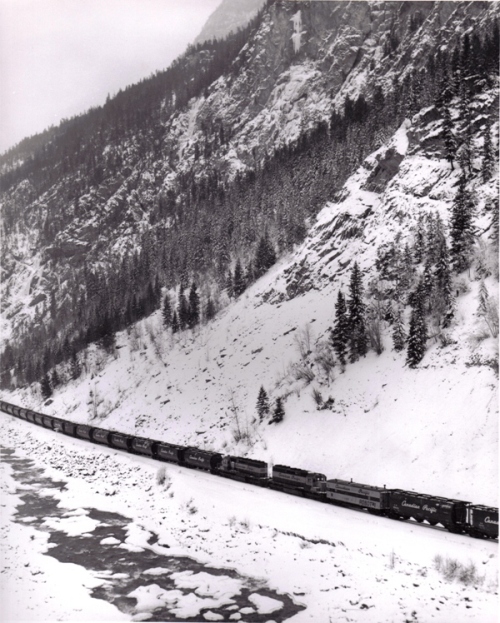 | |||
|
Hi Larry, I don't really know too much about the "slave units" as they didn't run them thru Deer Lodge. I do know that they spent a lot of time and money trying to make a cable fastened to the ceiling of of the tunnel on Mullan Pass out of Helena. I think it was a hit and miss affair. I don't remember what the years were though. I heard once that the slave units shoved the head end thru the steel doors on the west end of the tunnel one time. That may have been a story too, because the dispatcher should have had the door open, or the train ran a red signal. I do know that the Milwaukee Road used the mid train slaves a lot. But I don't remember any special car with them. I have been looking for some photos that I took of a derailment in the narrow Silver Bow canyon west of Butte where the Milw.,NP and BA&P funneled down thru going west, to put on here. But I have misplaced them somewhere. The W B Milwaukee came around a sharp corner and ran into a large rock and put the head end on the ground, and the slaves kept right on shoving and piled up a big bunch of cars. They ended up over the NP and the BA&P tracks also. All three railroads were shut down. The NP used the old Brownhoist loco cranes with a wrecker crew from Missoula to help clean up the mess and the Milw. used what we called then "The CatPak". I had never seen that method of cleaning up a wreck before. The main object was to skid the wrecked cars out of the way as fast as possible and get the track back in. Now that is common practice everywhere. Now the Remotes are on the rear of about every load going East or West. They seem to work really well. Its probably saving a lot of $$ on helper crews. Thanks for the insite on the slave units and their history. Bill Carlson | ||||
|
| IHC Member 163 |
Well, the N&W tried it once as a publicity trick, and made it into the Guiness World book of records for their efforts: The Guinness record shows this: "The longest and heaviest freight train on record was one about 4 miles in length consisting of 500 coal cars with three 3600 hp diesels pulling and three more in the middle, on the Iaegar, WV, to Portsmouth, OH stretch of 157 miles on the Norfolk & Western RR on Nov 15, 1967. Total train length was 21,424 feet and the train totaled 48,584 tons. The train was pulled by six N&W SD45 locomotives. There were three units on the lead and three mid-train slaves. The consist was as follows: N&W SD45 1737 N&W SD45 1740 N&W SD45 1726 300 loaded coal hoppers N&W SD45 1738 N&W SD45 1761 N&W SD45 1759 200 loaded coal hoppers N&W caboose 518263 " I recall this very well. It tied up the Portsmouth yards for hours! (grins) Regards! Mark | |||
|
I hope the yards were over 3 miles long or there were probably a lot of unhappy people who had crossings blocked. Bill Carlson | ||||
|
| IHC Member 163 |
It took them a while to break it up, and fortunately, there are a couple overpasses and underpasses in Portsmouth, so even though a LOT of crossings were indeed blocked for hours, there was a lot of announcements on the local radio station of the event and to use the other passes during the train movement. As I recall, it didn't seem to upset the flow of the town all that much. Portsmouth is/was a HUGE classification yard. Regards !Mark | |||
|
| Railway Historian IHC Life Member Site Moderator |
Hello Bill A close-up Canadian Pacific Robot car with 2 slave units in position on a grain train, the Robot car has two oil furnaces to keep the electronics from freezing up in the winter conditions of the Canadian mountain ranges. Will post some more pictures later. 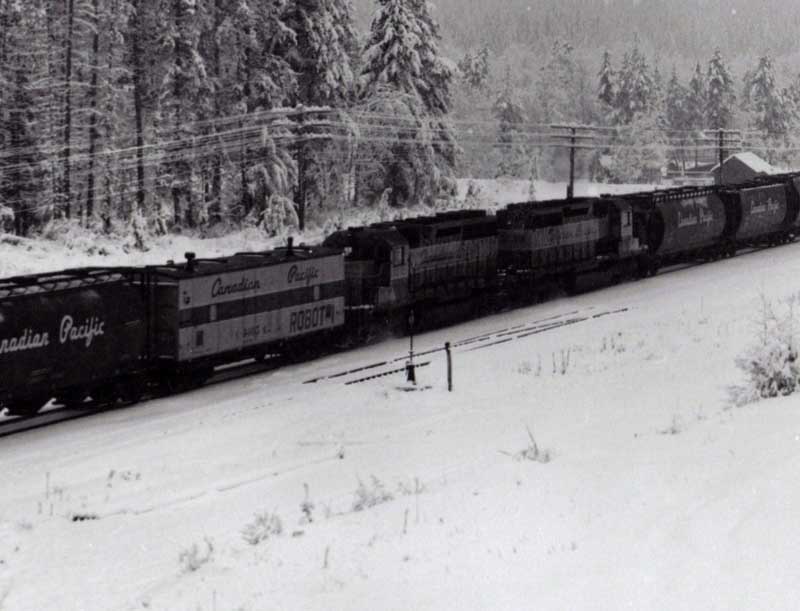 | |||
|
| Railway Historian IHC Life Member Site Moderator |
The cover Form MP 799 a CPR rulebook for Remote Control Locomotive Operation notice the radio signals going back and forth between the master and the slave locomotives for continuity. 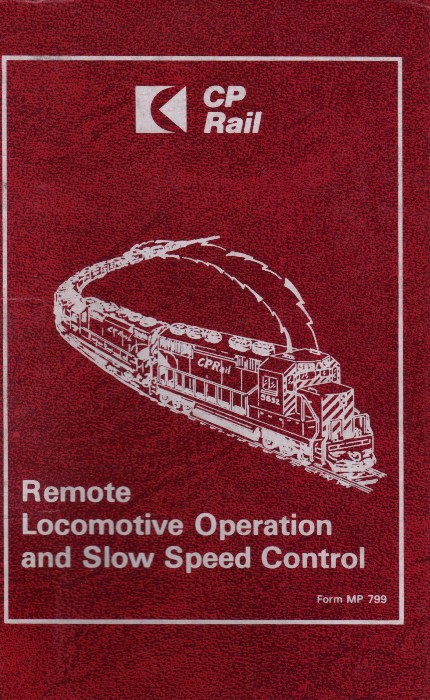 | |||
|
| IHC Member 163 |
Well, I'll say, Larry, I've NEVER EVER seen anything like this type rail damage before! Thank you for sharing it! I learned a lot from this thread! HIGH regards! Mark | |||
|
| Railway Historian IHC Life Member Site Moderator |
hello Mark: Sorry to burst your bubble, but there is a new world's record; On June 21, 2001 Queensland Rail now called BHP Iron Ore set a new world record for running the longest and heaviest freight train, between Yandi mine and Port Hedland in the Pilbara region of Western Australia. With 682 ore cars using eight distributed GE AC6000CW locomotives throughout the train in a 2-168-2-168-2-168-1-178-1 configuration. It contained 82,000 wet tonnes of iron ore and was 7.3 km (4.54 miles or 23971.2 feet) in length and ran for 275 km (170.88) under the control of one driver. Larry | |||
|
WOW!! Bill Carlson | ||||
|
| Railway Historian IHC Life Member Site Moderator |
Hello Bill: Here is another picture of Canadian Pacific Robot 1 with the original Master locomotive CPR 5775 that was used for the initial testing, the Robot car was originally express baggage car No. 4465 the conversion including installing two oil furnaces to keep the electronics from freezing up in the winter conditions of the Canadian mountain ranges, it was also fitted with storage cupboards, a table and two bunks for the technicians who were to monitor and service the equipment. This was taken at Alyth Shops in Calgary when it was being set up with its electronics circa September 1967. Larry 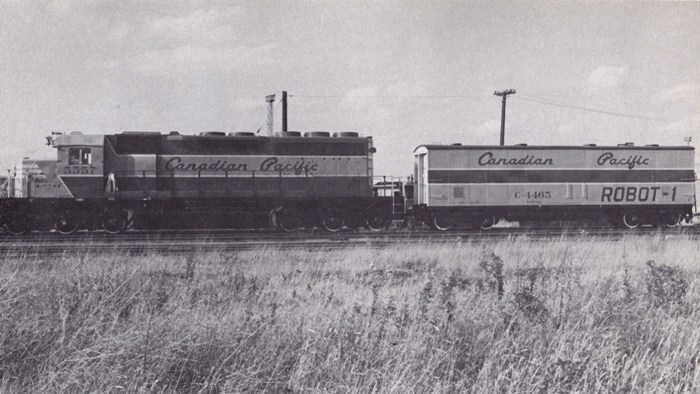 | |||
|
Thanks Larry, Very interesting stuff. Just think, what fit in the reefer car back then probably goes in a couple shoe boxes now. Good pictures. Bill Carlson | ||||
|
| Railway Historian IHC Life Member Site Moderator |
Hello Bill: You're right about the shoe boxes, I remember the fleet of original robot cars, many were made out of "B" unit bodies, the electrical cabinets were situated in the middle in a bulkheaded compartment, and on each end there were 15 foot long lengths of railway track welded together about 3 feet high to give the car enough ballast to keep it from jumping off the track. I laughed about your story of the robot running through the steel doors of the tunnel on the Mullan Pass and I do not doubt that it was true, the wiring on the roofs of tunnels was done extensively by the CPR to try to keep continuity between the Masters and the slaves, they were called tunnel repeaters but they didn't really work that well. There was one good story that happened on the CPR in British Columbia before they had the systems perfected, it appears that somebody had sabotaged a train when it was stopped on a siding they had closed both angle cocks between the robot car and the front portion of the train and had pulled the pin that uncoupled the train. The train carried on Westward and were being inspected by the track forces, the head end portion went by them going about 40 miles an hour, about three minutes past and the second unmanned portion of the train went by the sectionmen, alarmed they called the dispatcher and notified him of this peculiar event, he panicked and phoned the crew of the train and told them to stop immediately they complied and put the head end portion into emergency braking, and the remote portion just kept motoring along and ran into their stationary head end with disastrous consequences, fortunately nobody was injured but there was quite a cleanup. Larry Here is a photo from my rulebook showing a Locotrol 1 console from a master unit. 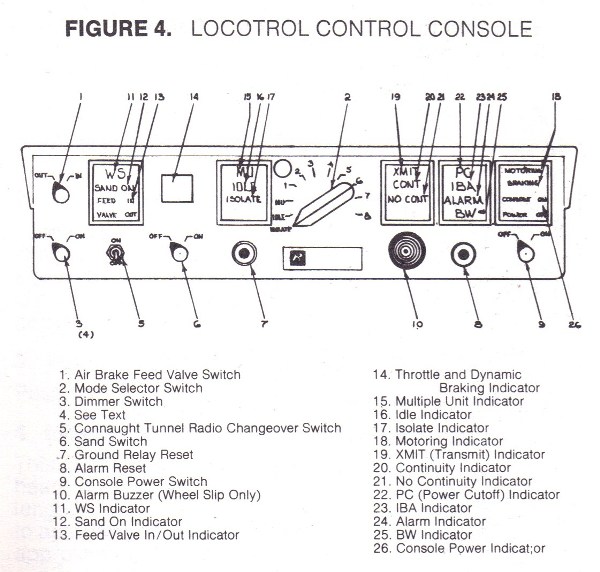 | |||
|
| IHC Member 163 |
WOW! Google needs to update it's listing. The N&W train is the only one that comes up in a search! Thanks again for the update! No bubble burst here! Regards! Mark | |||
|
Very interesting. I can't top any of this but.....I was on one freight that had 9 EMD units on the lead. A mix of F3's, GP7's, BL2's and GP9's. We wondered if we could operate at all since GM would only certify 3 units in a consist to retain control. They all answered the call in unison and we made the 115 mile run without mishap. I don't recall the tonnage or car count but must have been 120 or so, mixed freight. I hadn't thought of that run for years until reading this thread. It was usual for us to use 5-6 units on a regular basis in the winter season. | ||||
|
| IHC Member 163 |
What road did you work for, Larry, if I may ask? Regards! Mark | |||
|
Mark, you may ask! I worked on the BAR, Bangor & Aroostook. | ||||
|
| Railway Historian IHC Life Member Site Moderator |
Larry: We used to get some pretty big, consists of General Motors SD-40-2's, and robot cars coming back to Calgary Alberta, from Vancouver, British Columbia sometimes up to 24 units. Although not all of them were online, it was a real bonus for locomotive engineers as they were paid an additional $2.47 for each locomotive in their consist, which could add up to an additional $50 for the trip, and if it was before a statutory holiday it would be doubled, as you always claimed the trip worked before the holiday for pay on the holiday whether you worked or not. I've read a lot about the Bangor and Aroostook, they connected with the Canadian Pacific Railway, and the Canadian National Railways in New Brunswick, and they hauled a lot of potatoes that sustained them through the Great Depression, and provided 50% of their revenue following World War II, they had the second largest fleet of refrigerated cars in the United States to haul this traffic. Larry | |||
|
Larry: We hauled a lot of potatos and our reefer fleet was second only to the Santa Fe I believe. I was there to see it all go to pot. BAR used to lease to the west coast in the summer as part of their financing arrangement. We started to get into the mechanical reefers which we kept going for a long time. The good old days are sure gone, as well as the BAR. Larry | ||||
|
| Railway Historian IHC Life Member Site Moderator |
Hello Larry: Yes unfortunately times have really changed, and not for the better as far as I'm concerned. I've heard lots of horror stories from rails who worked on the Boston and Maine, Maine Central, and other New England carriers, when corporate raiders Guilford Industries took over and pillaged these properties. Larry | |||
|
| Powered by Social Strata |
| Your request is being processed... |
|
©2002-2025 Internet Horology Club 185™ - Lindell V. Riddle President - All Rights Reserved Worldwide

